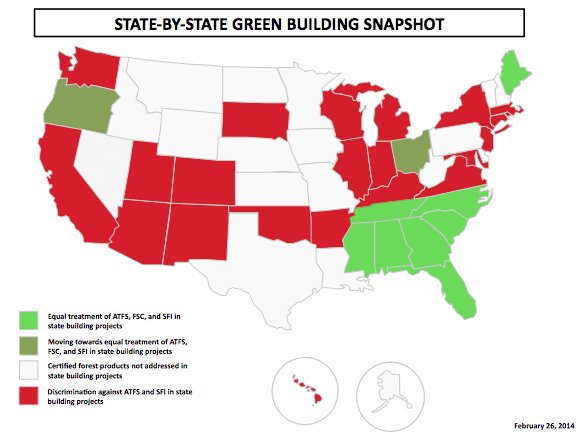
LEED Standards Continue to be Discriminatory to Forestry Industry
David Williams
February 26, 2014

Infographic above shows how LEED standards discriminate against Forestry
The Taxpayers Protection Alliance has highlighted how the U.S. Green Building Council’s Leadership in Energy and Environmental Design (LEED) green building certification system increases construction costs without guaranteeing greater energy efficiency. TPA has also explained how policies enforcing LEED standards unfairly discriminate against timber harvested from millions of acres of responsibly managed American forestland.
Specifically, LEED standards award a credit for certified wood to encourage sound management of forests. LEED, however, only recognizes timber certified by the Forest Stewardship Council (FSC), an international organization with standards that vary greatly. As a general matter, its standards are more stringent in the U.S., while significantly less stringent abroad – where 90 percent of FSC’s certified land can be found. Competing programs such as the Sustainable Forestry Initiative (SFI) and the American Tree Farm System (ATFS) enforce uniform standards, but they are not recognized by LEED, and timber harvested from forests certified by SFI and ATFS can get blocked from LEED projects.
It doesn’t make sense how an organization or government agency can defend a framework that considers wood harvested in (and transported from) Russia and Brazil under lax standards more “green” than wood harvested in the U.S. under stricter standards. Taxpayers shouldn’t be subsidizing public building and renovation projects that use foreign timber while discriminating against American wood.
For too long these problems were never addressed. In the last few years, however, there has been a growing scrutiny of LEED’s treatment of certified timber. The map below shows the current state of play. The states marked bright green took proactive steps to rebuke the USGBC and allow the use of ATFS, SFI, and FSC certified materials in public building projects. However, much more action must occur in all regions of the U.S. to create a level playing field for domestic timber products. Too many states (marked in red) still tilt the playing field against our domestic producers.
A 2012 study by the American Consumer Institute found that an FSC monopoly on all U.S. land would lead to a $34 billion annual loss to the domestic wood and paper market, while increasing product costs for American consumers by as much as 20 percent. Another report last year by EconoSTATS at George Mason University found that mandating FSC standards would cost tens of thousands of jobs in Arkansas and Oregon alone. LEED’s current requirements move us in this direction and create unfair incentives for builders to use foreign-raised lumber.
The USGBC had a chance to correct this market-distorting feature of its LEED rating system last year; it failed to do so. It will continue to fall on states to do the right thing and take action – whether by executive authority or legislatively – to support sustainable, American forest products.
LEED continues to be a scam on the environment and taxpayers. It is time for Congress to wake up and make sure more fiscal and physical damage isn’t done by LEED.
